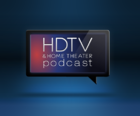 Sep 29
Sep 29 Podcast #811: Xfinity Instant TV and Wireless Home Theater
 Comcast is launching yet another video streaming service for you to consider purchasing. The cable giant announced today it's launching Xfinity Instant TV, what is essentially a bundle of local broadcast networks, for $18 per month. The service will only be available to Comcast broadband subscribers.
Comcast is launching yet another video streaming service for you to consider purchasing. The cable giant announced today it's launching Xfinity Instant TV, what is essentially a bundle of local broadcast networks, for $18 per month. The service will only be available to Comcast broadband subscribers.
| Download this Episode. |
Support the show with Patreon!
Listen to the show
Today's Show:
News:
- Netflix expands HDR support to Apple devices
- Paramount Network Launching Jan. 18, 2018
- Amazon announces new Fire TV with 4K and HDR for only $70
- Amazon starts selling Apple TVs again
Other:
- Optoma UHD60 and UHD65 Projector Reviews
- Optoma UHD65 4K UHD Home Cinema Projector
- Sony VPL-VW365ES vs Optoma UHD65 4K
- Epson Pro Cinema LS10500 vs Optoma UHD65 4K
- Epson Pro Cinema 4040 vs Optoma UHD65 4K
Amazon Prime:
Sign up for Amazon Prime and enjoy:
- Free Two Day Shipping!
- Instant Streaming of TV Shows and Movies
- Instant Access to thousands of Kindle Books
- The HT Guys gratitude!
Comcast announces new streaming video service for cord-cutters
Full article here
Comcast is launching yet another video streaming service for you to consider purchasing. The cable giant announced today it's launching Xfinity Instant TV, what is essentially a bundle of local broadcast networks, for $18 per month. The service will only be available to Comcast broadband subscribers.
This type of "over-the-top" offering is far from new. Comcast will be pitting itself against other services such as Sling TV, YouTube TV, and Hulu Live TV that also offer live television over the internet rather than a traditional cable subscription.
What's still unclear is the benefit this service would have over a simple TV antenna. Right now, most people can already get access to local standard cable channels using an HDTV antenna, which costs about $30. Based on what Comcast is saying, it appears there will be quite a lot of overlap.
"Available channels vary by region, but all Limited Basic lineups include popular broadcast channels like ABC, CBS, The CW, FOX, NBC, and PBS as well as public, educational, and government channels. Plus, most include Univision and Telemundo," Comcast says on a Xfinity Instant TV support page.
The only major drawback here is that the basic Xfinity Instant TV package doesn't come with popular cable channels like ESPN, CNN, MSNBC, or CNBC (ones that can't be accessed using a simple TV antenna). Those channels will cost customers an additional $30 per month.
Comcast is also offering an entertainment package that includes cable channels like A&E, AMC, Comedy Central, Discovery, Food Network TBS, TNT, and USA for an additional $15 per month. A kids and family option is also available for an extra $10 a month and includes channels like Cartoon Network, Disney Channel, MTV, and Nickelodeon.
Xfinity Instant TV will be available on most popular platforms including web browsers, mobile apps, and streaming devices such as Roku. Another weird detail: the subscription won't let customers rent or purchase videos on-demand. Customers also won't be able to buy pay-per-views with the service (sorry, UFC and boxing fans!).
The State of the (Wireless) Home Theater Comeback
Full article here.
It’s no secret soundbars have dominated the home theater space in recent years, leaving only a niche for complex, passive home theater systems. While soundbars allow for additional rear channels to be added and the TV sound experience to be elevated in many locations, they don’t present the same levels of power and definition as a system comprised of component speakers.
Fortunately, we are entering a new era in the world of high-definition home theater. Statistics show the time is now for a resurgence in surround sound systems. The content available to consumers is ready, and the production values of audio and video for TV, music, and movies are already great and continually getting better. However, for the venture to be successful, the installation and control experience needs to be extremely simple for consumers. Simply put, it needs to be free of wires.
Today, the consumer electronics industry has access to innovative technology that improves the home theater experience by standardizing and promoting quality wireless audio while assuring interoperability. As with most new technologies, there has been a period of investigation, testing, and integration into the roadmaps of many brands and manufacturers. Numerous brands, including Bang & Olufsen, Klipsch, Enclave and Axiim, have proven to be early adopters and brought high-performance systems to market that have been well received. Additionally, several key retailers are now allocating precious floor space to wireless home theater solutions. These are all great signs for the future of wireless home theater, but heightened adoption and implementation across the industry is necessary for the resurgence of true home theater.
The next leap forward is underway as we see more speaker brands creating assortments of products, as well as "source" brands like TV and gaming systems manufacturers incorporating the transmission of wireless home theater audio. As more momentum builds, it will only get easier for consumer electronics retailers to sell sources and speakers that provide consumers a wireless and interoperable home theater system offering the right components for an assortment of budgets and needs.
Retailers will also play a pivotal role in mass adoption given the significant power and influence they have to reinvent the home theater category through the convenience of wireless audio. Content providers, producers, networks, and any other parties involved in the creation and distribution of quality multi-channel content, also need to be talking about how much better the experience is with a great surround sound system rather than a TV audio experience or the minor upgrade from a sound bar.
In the current landscape, simplicity is common and therefore expected, but the majority of home theater systems require a myriad of wires and are often complicated to connect and install. Together, speaker manufacturers and retailers sit at a crossroads holding vast potential to create an extremely simple yet exceptional home theater experience that is uncompromising of performance.
Author: Tony Ostrom
Tony Ostrom is president of the Wireless Speaker & Audio (WiSA) Association, an industry group dedicated to bringing the industry’s only fully interoperable, high resolution, multi-channel wireless audio capability to consumer and professional products. His 25-year career in the consumer electronics industry has been focused on product planning and development, consumer research, go-to-market planning, technology integration, marketing and training.
Apple Invents a Smart Home Theater Audio System Designed to Deliver Optimum Surround Sound
Full article here.
Yesterday the US Patent & Trademark Office published yet another patent application from Apple adding to this common theme of patents that we've hyperlinked to above. The invention relates to an audio system that automates the detection, setup, and configuration of distributed speaker arrays using video and/or audio sensors.
When you combine the major theme of patents that we've pointed to including today's addition, it appears that this is what Apple is trying to achieve for a future Apple TV system. Perfect surround sound that's so intelligent that it smashes the concept of stereo sound in the home and introduces us to true intelligent audio.
The intelligent sound system uses an iDevice camera and with a depth camera that can analyze where people are sitting, what objects are in the room and automates the speaker arrays to ensure that surround sound would be heard by all, even if family or friends aren't exactly centered to the screen. This would be an amazing achievement if the Apple team could eventually bring this to market.
Patent Background
Speaker arrays may reproduce pieces of sound program content to a user through the use of one or more audio beams. For example, a set of speaker arrays may reproduce front left, front center, and front right channels for a piece of sound program content (e.g., a musical composition or an audio track for a movie). Although speaker arrays provide a wide degree of customization through the production of audio beams, conventional speaker array systems must be manually configured each time a new user and/or a new speaker array are added to the system. This requirement for manual configuration may be burdensome and inconvenient as speaker arrays are added to a listening area or moved to new locations within the listening area.
Optimizing the Performance of an Audio Playback System with a Lined Audio/Video Feed
An audio system is provided that efficiently detects speaker arrays in a listening area and configures the speaker arrays to output sound. In one embodiment, the audio system may include a computing device that operates on a shared network with one or more speaker arrays and an audio source. The computing device may detect and record the addresses and/or types of speaker arrays on the shared network.
In one embodiment, a camera associated with the computing device (iPhone) may capture a video of the listening area, including the speaker arrays. The captured video may be analyzed to determine the location of the speaker arrays, one or more users, and/or the audio source in the listening area. These determined locations may be determined relative to objects within the listening area.
While capturing the video, the speaker arrays may be driven to sequentially emit a series of test sounds into the listening area. As the test sounds are being emitted, a user may be prompted to select which speaker arrays in the captured video emitted each of the test sounds. Based on these inputs from the user, the computing device may determine an association between the speaker arrays on the shared network and the speaker arrays in the captured video. This association indicates a position of the speaker arrays detected on the shared network based on the previously determined locations of the speaker arrays in the captured video.
Using the determined locations, the computing device may assign roles to each of the speaker arrays on the shared network. These roles may be transmitted to the speaker arrays and the audio source.
In some embodiments, the test sounds emitted by the speaker arrays and the captured video captured by the computing device may be further analyzed to determine the geometry and/or characteristics of the listening area. This information may also be forwarded to the speaker arrays and/or the audio source. By understanding the configuration of the speaker arrays and the geometry/characteristics of the listening area, the speaker arrays may be driven to more accurately image sounds to the users.
As a patent tidbit, the image that is shown in the figures 8B and 8C are actually related to Apple TV and a granted patent that we covered in February titled "Apple Granted 38 Patents Today Covering an Original Apple TV Related Invention, Dual Mode Headphones and more." That patent was actually filed in 2006, before the iPhone came to market. The exact patent figure of the two gentlemen was found in the original patent under figure 15 as noted below.
The Message: the audio system of the future is seen to be in sync with Apple TV.
“‘I’d like to create an integrated television set that is completely easy to use,’ he told me. ‘It would be seamlessly synced with all of your devices and with iCloud.’ No longer would users have to fiddle with complex remotes for DVD players and cable channels. ‘It will have the simplest user interface you could imagine. I finally cracked it.’” -Steve Jobs, Aug 2011


Reader Comments (1)
Too bad you guys went on and on about how you aren't happy with what you described as the politicization of the NFL games. If your goal was to remain neutral, then neutral comments were warranted. Instead, the patter came off as flippant toward the deadly subject of the protests and toward the attempt by the president to silence those who don't subscribe to the morally objectionable extremes of his ideology. Neutral commentary would not have placed blame for your disappointment by calling out the NFL and Goodell as you did.